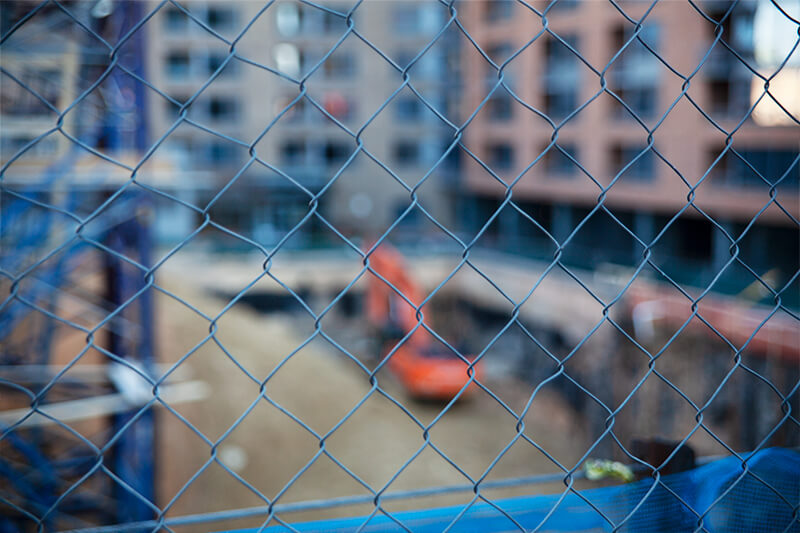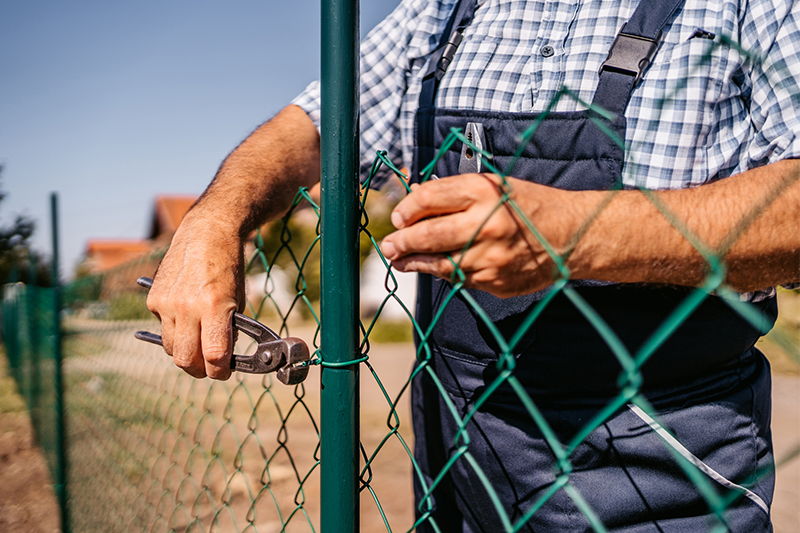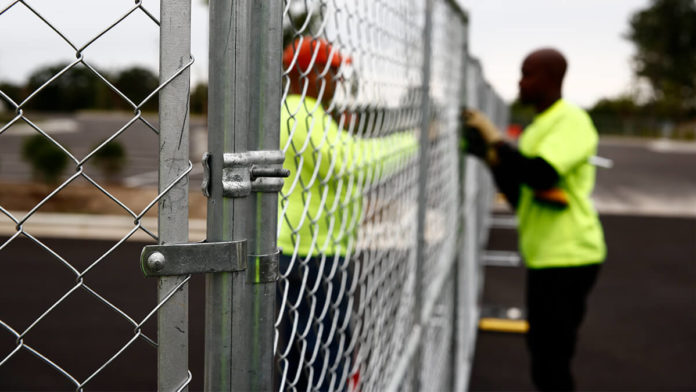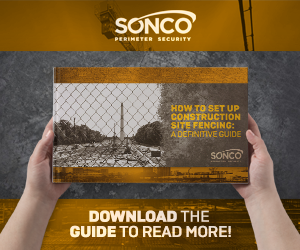Chain-link fence styles and features might appear daunting to those new to perimeter security. That’s why we’ve created a detailed guide on chain-link fences, answering your most common questions.
Essentially, there are two different types of chain-link fence and each requires specific techniques and materials to properly install.
DIY fence installation is easier than you might think as long as you have good, easy-to-follow instructions. In some instances, it may not be practical, but if you have the time and ability, self-installation of your chain-link fence may be the best route for you.
Here’s how to install chain-link fence.
What are the Types of Chain-link Fencing?
The most distinct characteristic of chain-link fencing is that it is made of woven wire that is linked together by hooking the wire on each side.
The wire is linked so that it forms a diamond pattern that tends to run vertically. The wire is usually either galvanized or coated using PVC or polymer coatings.
The benefits of chain-link fencing are that it is functional as well as durable, making it appropriate for both residential and commercial use as well as construction sites, parks, and secure enclosures.
There are two basic types of chain-link fencing:
- Panel – Chain-link fencing that is available in individual pre-constructed panels that can stand alone or be linked together. Panel chain-link fencing works well for construction sites, events, and other settings where temporary fencing is needed.
- Mesh – Chain-link fencing that is available as a mesh fabric that is stretched across a panel’s rails at the top and bottom and secured with metal tie wires.
What are the Benefits of Panel and Mesh Fencing?
Both types of fencing offer the benefit of creating a stable, secure perimeter or barrier.
They are cost-affordable options that are easily adaptable and low maintenance. They create a barrier that provides security while still allowing for visibility. They can be adjusted to fit any space, regardless of the shape or size and the height can be customized as well.
Panel fencing
Typically utilized for temporary purposes like construction sites or special events, fence panels offer the security of permanent fencing while also providing the convenience of portability, along with easy setup and breakdown.
Mesh fencing
Appropriate for permanent settings, mesh fencing is not as easily portable once it is set up. However, it may be practical for a long-term setup, as it is usually anchored on the ground and requires little maintenance.

How do you Install Panel Chain-link Fencing?
While DIY fence installation may help you cut costs, professional installation is more convenient and faster.
Also, certain municipalities may require professional installation as well as federal regulations for certain industries. Before beginning your project, you should check your local laws first to ensure that you are compliant.
The first step in securing your area or jobsite with temporary fencing is determining its purpose. Assess the space and map out the placement of the fence.
You want good, solid ground that will keep the fence stable, even in moderately harsh weather. Also survey your site for any obstacles such as power lines, water lines, heavy debris, and other things that may make it difficult to erect your fencing.
What Materials are Needed to Install Panel Chain-link Fencing?
You will need to get enough fencing panels for the area that you want to fence in. You’ll also need heavy work gloves, heavy-duty wire cutters, fence panel couplers (clamps), a drill, and heavy-duty wire.
If you are going to set the poles in the ground, then a post-hole digger is helpful. If you are going to use stands or anchor bases, you will need those materials as well.
We recommend the use of anchor bases to enhance the stability of the fence. These bases serve as temporary foundations, securely anchoring panels to the ground and preventing them from toppling, even under adverse conditions.
What are the Steps for Installing Panel Chain-link Fencing?
There are several steps for installing a panel chain-link fence, but it is a straightforward process.
- Map out your fence placement to decide where the posts will be placed and how the fence will be set around the area.
- Position the fence feet and the anchor bases, so that you can easily set up your panels.
- Once the fence base is in the correct position, you can begin placing your chain-link panels by positioning the posts into the fence base holes.
- Use a drill to install the metal fence couplers that secure the panels together.
- Add accessories such as gates for access into the area and wheel kits to allow for easier mobility.
- If privacy is needed, install custom fence covers or privacy screens to limit visibility into the secured area.
It is recommended that you review the fence specification and inspection resources. This can provide more information on ensuring that your fence is installed properly, wind load information, and more. You can also tap into technical support if you need it.
How do you Install Mesh Chain-link Fencing?
Installing mesh chain-link fencing is a little more involved than installing panels, although some of the basics remain the same. As with panel fencing, first determine the purpose of your fencing.
Once you have determined its function, survey your area and map out the fence placement. Solid ground that is not too soft or too rocky is ideal.
You don’t want to set your fence in ground that is so soft that a good, strong wind will knock it over. By the same token, you don’t want to set it in the ground that is so rocky it is nearly impossible to dig deep enough to set the poles properly.
Sandy or soft soil can be mitigated using cement to secure the posts. This will help ensure the stability of your fence. Again, as with panel fencing, look for obstacles like heavy debris, water lines, power lines, and other things that will make erecting your fence difficult or impossible.
You may need assistance from two or more people to help you set up this type of fencing.
What Materials are Needed to Install Mesh Chain-link Fencing?
The materials you’ll need to install mesh chain-link fencing are similar to installing panel fencing. Assemble your materials before beginning your project to ensure that you have everything you need. Make sure that you have enough posts and mesh.
You will also need a few extra materials, such as end posts for each fence end, along with end post caps, rail ends, tension bars, and tension bands.
For the posts between the end posts (intermediate posts), you will need intermediate post caps for each and fence ties. You will also need a top rail. At the corners, you will need corner posts and if you install a gate, you will need gate posts.
A pair of sturdy gloves, heavy-duty wire cutters, a fence puller, a drill, heavy-duty wire, a level, and a post-hole digger are also recommended. If you are using cement or stones to secure the posts, you will need that material as well.

What are the Steps for Installing Mesh Chain-link Fencing?
Installing mesh chain-link fencing is more challenging compared to panel fencing, but DIY installation may still be feasible.
- Calculating your materials is a very important step here because there are so many parts. You need to know how many end posts you’ll need. Typically, you only need two, but if you have several areas where the fence butts up against a building or other obstacle, an extra post will be needed. You also have to decide on the number of corner posts and gate posts as well as how much mesh is required.
- Mark your post locations and install them. Once you have established all of your post locations, dig the holes so that about three quarters of the post is above ground and a quarter of the total post is in the hole. If you are using rocks or cement, dig your post holes about three times wider than the post itself.
- If you’re using cement to secure the pole, place a 4-inch layer of gravel at the bottom for drainage and put the pole and cement on top of it. If using stones, they will have enough space between them to allow for drainage.
- Use a level to make sure that the posts are straight.
- Add tension bands and caps to all posts.
- Install the top rail by running it through the loops on the intermediate post caps and securing it in the end cap. Once it is in place, secure it with nuts and bolts.
- Lay the roll of mesh fencing next to one of the end poles.
- Start at one end and weave the tension bar through one end of the mesh. Secure it to the end post, ensuring that the mesh is about 2 inches from the ground.
- Begin unwinding the mesh roll along the fence length, pulling tightly to prevent any slack. Use wire fence ties to secure the mesh to the top rail.
- When you get to the other end post, weave a temporary tension bar into the mesh about three feet from it. Use the fence puller to tighten the mesh. When it is tight enough, weave the permanent tension bar through that end of the mesh and secure it. Remove the temporary tension bar.
- Install fence ties along the top at about two-foot intervals.
- You may also want to weave tension wire along the bottom through the lower portion of the mesh, securing at each end post.
Check with local laws and regulations in your area to ensure you are compliant. You may also want to check out the technical information for the type of fencing you choose.
Wrapping Up Your Chain-link Fence Installation
In conclusion, installing chain-link fencing can be a rewarding DIY project with the right guidance.
Understanding the different types of chain-link fencing, such as panel and mesh, along with their respective benefits, helps you make informed decisions for your project.
As you embark on your installation journey, remember to assess your space carefully, gather the necessary materials, and follow the step-by-step instructions provided. While installing mesh chain-link fencing may pose more challenges than panel fencing, DIY installation is feasible with proper planning and execution.
After installing your fence, learn how you can customize it with accessories for extra features and added security.




